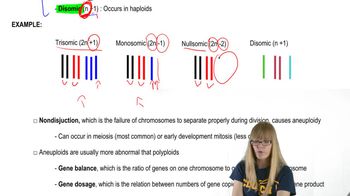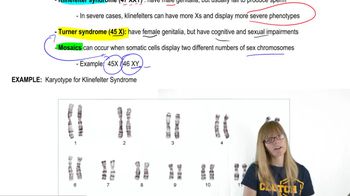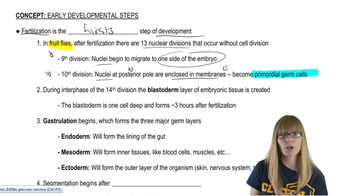Table of contents
- 1. Introduction to Genetics51m
- 2. Mendel's Laws of Inheritance3h 37m
- 3. Extensions to Mendelian Inheritance2h 41m
- 4. Genetic Mapping and Linkage2h 28m
- 5. Genetics of Bacteria and Viruses1h 21m
- 6. Chromosomal Variation1h 48m
- 7. DNA and Chromosome Structure56m
- 8. DNA Replication1h 10m
- 9. Mitosis and Meiosis1h 34m
- 10. Transcription1h 0m
- 11. Translation58m
- 12. Gene Regulation in Prokaryotes1h 19m
- 13. Gene Regulation in Eukaryotes44m
- 14. Genetic Control of Development44m
- 15. Genomes and Genomics1h 50m
- 16. Transposable Elements47m
- 17. Mutation, Repair, and Recombination1h 6m
- 18. Molecular Genetic Tools19m
- 19. Cancer Genetics29m
- 20. Quantitative Genetics1h 26m
- 21. Population Genetics50m
- 22. Evolutionary Genetics29m
6. Chromosomal Variation
Chromosomal Mutations: Aneuploidy
Problem 6
Textbook Question
Textbook QuestionWhat evidence indicates that humans with aneuploid karyotypes occur at conception but are usually inviable?
 Verified Solution
Verified SolutionThis video solution was recommended by our tutors as helpful for the problem above
Video duration:
1mPlay a video:
Was this helpful?
Key Concepts
Here are the essential concepts you must grasp in order to answer the question correctly.
Aneuploidy
Aneuploidy refers to the presence of an abnormal number of chromosomes in a cell. In humans, this condition can arise from errors during meiosis, leading to gametes with extra or missing chromosomes. Common examples include Down syndrome (trisomy 21) and Turner syndrome (monosomy X). While aneuploidy can occur at conception, many aneuploid embryos fail to develop properly.
Recommended video:
Guided course

Aneuploidy
Karyotype
A karyotype is a visual representation of an individual's complete set of chromosomes, organized by size and shape. It is used to identify chromosomal abnormalities, such as aneuploidy. Karyotyping can reveal the number of chromosomes and any structural changes, providing crucial information about genetic disorders and their potential viability.
Recommended video:
Guided course

Human Sex Chromosomes
Embryonic Viability
Embryonic viability refers to the ability of an embryo to develop into a healthy fetus and ultimately a live birth. Many aneuploid embryos are inviable due to the severe genetic imbalances they present, which disrupt normal development. Research indicates that a significant proportion of conceptions with aneuploid karyotypes result in early pregnancy loss, highlighting the critical role of chromosomal integrity in successful gestation.
Recommended video:
Guided course

Drosophilia Development
Related Videos
Related Practice



